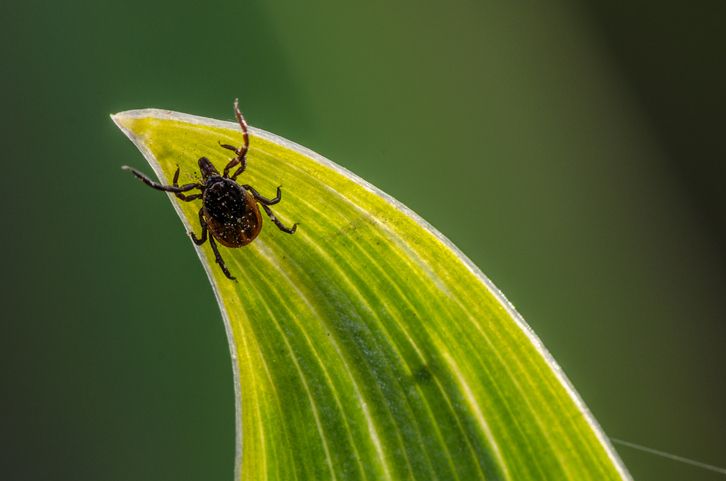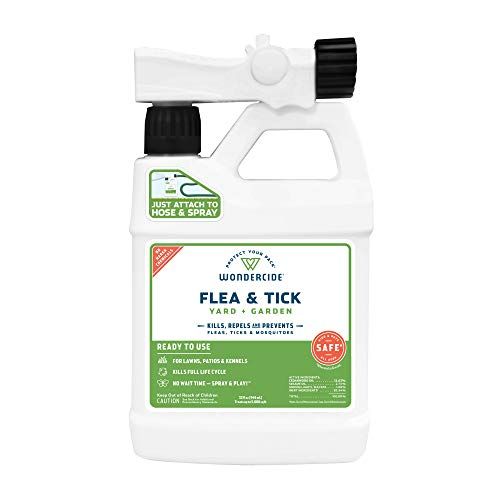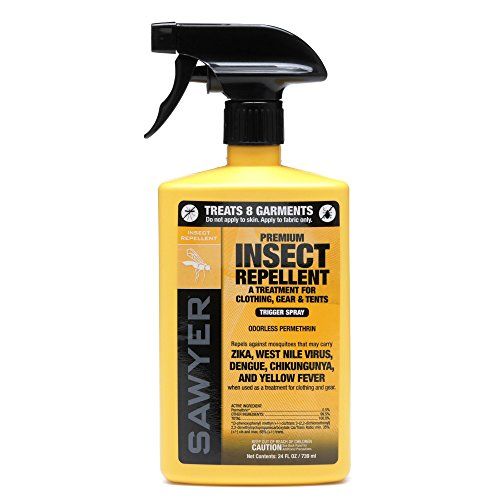Maybe you’re itching to start a garden or relax on your lawn. Or, perhaps you can’t wait to hit the hiking trails or go camping. All fun things! But any time you relish in the great outdoors you also risk exposing yourself to some pesky little buggers: ticks. So, it’s crucial to know how to avoid and get rid of ticks.
While ticks are *technically* around all year and present in virtually every U.S. state, they tend to cause the most trouble from April to September, per the Centers for Disease Control and Prevention (CDC). “Wherever you are, when it starts warming up, that’s when insects and ticks are going to be proactive,” says Walter Schrading, MD, director of the Office of Wilderness Medicine at the University of Alabama at Birmingham.
What’s more: Cases of tickborne diseases like Rocky Mountain spotted fever and Lyme disease have more than doubled in the past 13 years, and the little critters that cause them have been expanding their territory, per the CDC.

This doesn’t mean you have to confine yourself to the couch during warm-weather months (and please don’t). The key is to lower your chances of being bitten by prepping your yard, clothes, and gear, and to know exactly what to do if you find a blood-sucker on you.
Consider this your crash course in how to get rid of ticks, keep ticks away altogether, and what to do if you get bitten, with expert insight from doctors and tick experts.
What are the best ways to get rid of ticks in your yard?
Good news: The yard work that’s already on your to-do list this time of year will help keep your tick exposure to a minimum. Ticks thrive in woodsy, high-humidity areas, and their carriers (such as deer, mice, and raccoons) are apt to wander through tall grasses or hide in piles of leaves, wood, and other debris.
So, cleaning up your yard could help lower your chances of welcoming in ticks and the animals that carry them. “Ticks do not like sunny, manicured lawns,” says Sunjya Schweig, MD, scientific advisory board member for the Bay Area Lyme Foundation and co-director of the California Center for Functional Medicine in Berkeley, California.
Here are a few ways to keep your yard as tick-free as possible:
- Keep your grass short. Ticks tend to climb onto you from surrounding greenery, so mow your lawn often (especially around the edge of your yard, fence, and sitting areas), promptly rake up and remove leaves, and prune bushes and trees, says Jim Fredericks, PhD, chief entomologist for the National Pest Management Association.
- Create tick-safe hangout spots. Looking for a fun project for spring? Consider laying down a gravel or stone walkway or patio for an area near your home where you don’t have to be on guard for ticks so much, or spread three feet of wood chips or mulch around the border of your yard to deter unwanted invaders, the CDC recommends.

- Spray for ticks. You can spray areas in your yard with a pesticide that contains bifenthrin (the gold-standard chemical for tick control) yourself, but a licensed pest control pro will know exactly when to spray (sometimes, in early spring, summer, and fall) and where. You typically want to spray along the perimeter of your yard, but you may want to coat just about everywhere, depending on where you live, says Thomas Mather (a.k.a. The Tick Guy), PhD, director of the Center for Vector-Borne Disease and its TickEncounter Resource Center at the University of Rhode Island in Kingston. You should be aware that some sprays can also deter bugs you might want around, like bees, so if that’s one of your concerns, you might want to consider a natural spray like Wondercide. The repellent is plant-based and doesn’t present a hazard to pets, plants, or kids. It’s made without harsh chemicals, and powered by cedar essential oil. One caveat: Experts don’t know if this natural spray is as effective as other chemical sprays, so consult a pest control expert to access your situation before relying on it.

- Put up a fence. If there’s room in your budget, fencing can help keep out some tick magnets, like deer. Another option: Plant a garden to keep deer away with lots of wildflowers and fragrant herbs like rosemary and mint which, lucky for you, they don’t like, says Dr. Schweig.
- Add some tick tubesto your yard. They’re basically cardboard tubes that have been treated with an insecticide called permethrin. The tubes are designed to target ticks that may live on mice or where they burrow. “The idea is to place these tubes around your property so that mice can find them, take the treated cotton in them to their burrow to use for nesting material. Any ticks that are on the mouse or in the burrow will be killed by the permethrin,” says Marc Potzler, board-certified entomologist for Ehrlich Pest Control. White-footed mice are known to carry the bacteria that causes Lyme disease.
What are the best ways to get rid of ticks in your house?
There’s no need to treat the inside of your home for ticks. “With the exception of the brown dog tick, most ticks cannot survive and reproduce indoors,” says Fredericks. (Whew.) As such, your goal should be to make sure you’re not bringing ticks in with you.
Here’s what to do for a tick-free home:
- Check yourself as soon as you get in. After you’ve been outside, head for a full-length mirror to do a quick tick check (it only takes about 30 seconds), says Mather. Some hot spots to look out for: Under your arms, around your ears, inside your belly button, behind your knees, between your legs, around your waist, and in your hair.
- Hit the shower. Some ticks that are most likely to pass on infections like Lyme disease are about the size of the period at the end of this sentence (ugh). So, if you’ve been in a tick-friendly area, taking a shower is one of the easiest ways to shed super-tiny ticks that haven’t latched on but are on the prowl, says Dr. Schweig.
- Protect your pets. Make sure to check your pup or cat for ticks (and perhaps don’t let them hop onto your bed or couch if they just came in), says Mather. For a long-term solution, ask your vet about monthly preventative meds if they’re not on them already, per the CDC.
- Heat up your laundry. After being outside or in wooded areas, wash and dry your dirty clothes on high-heat settings to kill ticks (even just 10 minutes in the dryer will do the trick), per the CDC. Check the label on your backpack and camping gear and throw them in, too, if possible.
- Spray in indoor-outdoor spaces. Though ticks can’t live indoors due to humidity levels, they can dwell in spaces like cabins, storage sheds, and doghouses. “Ticks need very high humidity levels: 85 percent or higher to develop. This level is generally not found indoors, especially in combination with the other needs of ticks for reproduction,” says Potzler. He also points out that ticks need vegetation to hide from the sun while looking for a host, as well as leaf litter or logs to lay eggs under. Searching for a host is known as questing, which is when ticks hang out at the end of a branch or other protrusion along an animal pathway, waiting for a potential host to come by. That environment can be found in something like a doghouse or shed, or your dog can carry ticks in its fur, so you’ll want to spray the windows or baseboards of indoor-outdoor areas like this with a natural pesticide like Wondercide to be extra safe.
- Sprinkle diatomaceous earth in indoor-outdoor areas. Diatomaceous earth (DE) is a natural tick repellent that’s mined from the earth. “It’s actually the glass shells of diatoms, which are minute sea creatures. As the diatoms die in the sea, the glass shells pile up on the seafloor,” says Potzler. Ticks don’t like it, and it’s non-toxic and safe for other arthropod animals, like caterpillars. “When applied properly, it would provide protection against ticks in the tufts and folds of bedding and the adjacent baseboards and cracks.” But Potzler says that DE can cause physical abrasion and irritation to the eyes and skin if improperly handled, or lung issues if inhaled, so make sure to follow all the directions when putting it down to avoid any issues.
If you do find a tick has made its way into your home, resist the temptation to squish it (which could expose you to the infectious germs it’s carrying) and flush it or bag it instead.
What’s the best way to get rid of a tick on your body?
Let’s start with what *not* to do: Don’t yank it off and smash the bugger. If you rip it out, the tick’s mouth could remain, along with the germs that cause infection and disease, explains Dr. Schweig. Ignore the old wives’ tales, too: Nail polish, vaseline, gasoline, and matches are never safe tick-removal tools, says Dr. Schrading. (If it sounds weird or dangerous, it’s probably not a good idea.)

Instead, grab a pair of fine-tipped tweezers and follow this handy guide to remove a tick:
While some diseases might be transmitted more quickly, in most cases, you’re not going to develop Lyme disease if you remove a tick within 24 hours. If you’re worried it’s been longer than that, you can’t remove the tick, or you start to develop symptoms like a fever or rash, call a doctor to figure out what you need to do.
Make sure to tell the doctor when and where you believe you were bitten, but don’t worry about bringing the tick along for your appointment—your doc will know what to do without having to examine the actual tick that bit you, says Dr. Schrading.
What’s the best way to avoid getting a tick bite altogether?
Thankfully, protecting yourself from ticks is pretty easy. Here’s how to reduce your chances of getting bitten by a tick:
- Tick-proof your wardrobe. Before you head into the woods, treat your shoes and clothing with insecticides that contain 0.5 percent permethrin by following the instructions on the label (pro tip: spray them until they’re actually wet, not just with a light spritz, and re-spray after six washes). Or, get pre-treated gear from a company like Insect Shield (which lasts up to 70 washes!), says Mather.

- Cover up. No permethrin spray on hand but have plans to spend a lot of time outside? At least seal yourself off from ticks the best you can. Wear leggings or pants tucked into boots with socks pulled over them, tuck in a light-colored long-sleeve tee (which makes it easier to spot crawlers on you), and put on a wide-brimmed hat.
- Spray on tick repellent. Use an EPA-approved tick repellent that contains effective active ingredients (read: at least 20 percent DEET, IR3535, picaridin, or oil of lemon eucalyptus), per the CDC. Off! Deep Woods Insect Repellent, Cutter Lemon Eucalyptus Insect Repellent, and Sawyer Products Premium Insect Repellent all fit the bill.
- Know where ticks like to chill. Trail running, gardening, hiking, and camping could all put you in tick territory, so stick to the center of well-worn paths and don’t wander off into tall grasses for a photo op.
Ultimately, after all of your exploring, one of the easiest things you can do to keep yourself safe from ticks is to make tick checks a habit and hop in the shower (you’re probably sweaty, anyway!). And the faster you find and flush a tick, the better.
And while not every tick is carrying disease (most tick bites are totally harmless), it’s always better to be safe than sorry. So protect yourself first and foremost, and don’t hesitate to talk to a doctor if you’re unsure about a bug bite.
Source: Read Full Article
